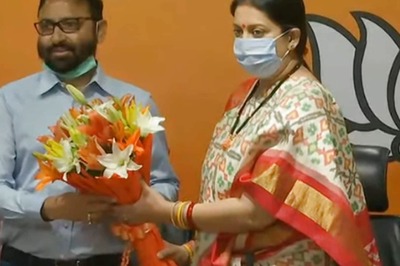
views
Gond, Bhil, Rathwa, Saura arts —tribal art forms explode with the colours of India, her flora, mythology and folklore. Most importantly, they capture the perceptions of traditional artisans as they celebrate festivals, the rites of passage, and life itself. ‘Abhivyakti’, presented by Indira Gandhi Rashtriya Manav Sangrahalaya (IGRMS), Bhopal, brings each of these traditional art forms in a series of 52 frames. The exhibition mounted at the State Museum here captures the essence of ancient folk and tribal paintings as they move beyond their traditional canvas, even their motifs, to meet contemporary challenges.Tribals live in complete harmony with nature and their art works are inspired by their beliefs, tradition and simplicity of life.And tribal arts give an insight into basic human nature and lifestyle.The paintings on display, mostly made by Gond tribals, are very basic in interpretation. They are painted on walls and floors of the houses of the community people. The subjects are from daily rustic life, be it chaffing of paddy, grinding of corn or sieving grains. The ‘dhan kutnevali madin’ or the lady who separates the grain has a pride of place in their lives and so she is celebrated just as the ‘chulawali,’ who lights the kitchen fire, are illustrious subjects. The whole cycle of village life is artistically cast in canvasses.If one looks carefully the art on show has every nuance of tribal life, raising it to artistic height.Their gods and goddesses, the Maswasi Dev and Narmada (river) Mata, Raat Mai Devi, their musicians, the ‘baja’ and the ‘dafliwala’ are all part of a venerated culture. And then the forest buzzing with wildlife is their source of livelihood. The animals with which they coexist in harmony are all there.It is this symbiotic existence that allows for such graphic picturisation of the fowl and the fish. The deer (hiran), the fish (machri), the frog (beng), the crab (kekeda), turtle (kachuva) and even the scorpion (bichu) are cast in colourful precision. The toddy-tapper is another common image.Then there is the ‘madiya mundi’ or the headman, cast as a man with a headgear. The Karma Vriksha or Tree of Life is the popular folklore of the cycle of regeneration.For a layman, the paintings may seem to be geometric patterns and may even fail to communicate the underlying significance of major events associated with life and death; but for the tribals the essence of the paintings is perceptible and is a reflection of their world view, complete with a range of emotions.“When they do the art on the walls of their house, they use local stones for red ochre colour and white rice flour for soft colours.While working for commercial they use acrylic colours which are locally available,” said the Director of IGRMS Kamal K Misra who was here to inaugurate the exhibition. Now, the tribal artisans are doing the art not only on their houses but also on canvas, cloth and other fabrics for commercial purposes, he added. The exhibition is on till January 15.



















Comments
0 comment